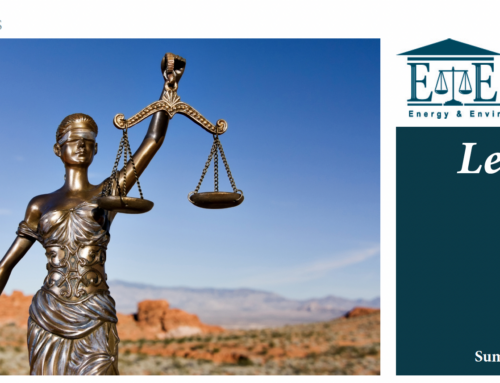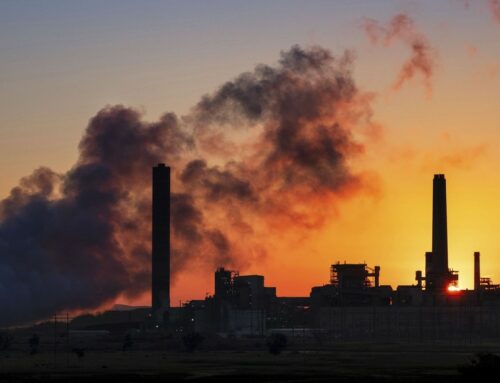by David W. Schnare
General Counsel
EPA received over two million comments on its proposal to shutter about half of all coal-fired power plants using authority it claims it has under Section 111(d) of the Clean Air Act. EPA calls this its “Clean Power Plan” and through the rule would require States to establish a State Implementation Plan (SIP) to implement a four part rule. More than half the states in the union think the rule is fatally flawed. Most think it is illegal in the first place. Even states that fully buy into climate alarmism think the targets EPA set are unachievable.
EPA knows it is facing both legal and technical challenges and reports from inside the agency suggest they will try to soften the blow by easing the first set of targets, while keeping the equally unachievable final targets.
The initial reaction of many states has been to consider some form of “wait and see” approach. They are concerned that early efforts to comply with the rule, as would be necessary to meet EPA’s harsh deadlines, would cause utilities to make decisions on shutting plants and otherwise changing their engineering – changes that could not be undone but would also be unnecessary if the rule is found to be illegal.
On their part, utilities are neutral. They will get paid no matter what they do, as long as they can show they had to do it because of federal or state environmental rules. All utilities want is some certainty. Utilities calculate that if the state does not act, EPA will, replacing the SIP with a FIP, a Federal Implementation Plan. Indeed, early reports that states will not submit plans has caused EPA to prepare a generic FIP that they can impose on the day the states would otherwise have had to submit their SIPs.
States are also concerned about whether they will lose highway construction funds if they do not submit a plan. Because of the clear message the Supreme Court provided in NFIB v. Sebelius, EPA is no longer allowed to use the highway funds hammer. EPA, of course, rejects that premise and the matter will have to be litigated. In the meantime, states may be at risk.
In light of all this, E&E Legal has been asked for advice on how a state might deal with all these uncertainties and still protect its interests. We suggest an approach we call the “Plain Jane Plan.” It is a form of “wait and see,” but a form that limits EPA to well established practices that have the benefit of taking substantial time – enough time to ensure no plan is put into place until the legal issues are resolved.
Delaying Highway Fund Coercion
We have been asked to estimate the amount of funds states could lose if EPA uses this coercive hammer. The actual amount of funding that can be withheld is extremely state specific, so we cannot make an estimate of the number. The process EPA uses, however, is quite clear. The Congressional Research Service explains the process in a report that is somewhat dated but is informative and accurate. The key point of the report is that if a state files a SIP, EPA must use a “sanctions clock” that gives the state plenty of time to work the issue before any sanctions can be imposed. Here is how the sanctions clock works.
Sanctions cannot be imposed until 18 months after an EPA finding that a SIP is insufficient. Hence, the legal battle over the 111(d) rule will likely be decided by then and the state would not have to submit a plan until sometime in 2018 to avoid sanctions, but might submit a Plain Jane Plan to delay everything.
EPA does not begin with funding sanctions. Rather, it first imposes a 2 for 1 emissions limitation on new permits. Because the only part of the 111(d) rule that would be affected by this would actually be 111(b) new sources, and since EPA seems to be waffling on what the NSPS (111(b)) requirements are going to be, this sanction is a bit difficult to predict. Probably it will mean no new coal plants, but might mean no new natural gas plants too since it is impossible to cut CO2 emissions from gas plants by 50 percent from the 111b limits for any new plant. Stopping natural gas plants, however, would go against the grain for EPA, and they may not go beyond coal plants. In any case, the 2 for 1 element, alone, adds six months to the process.
The highway funds problem thus begins only 24 months after EPA decides a state has not submitted an acceptable SIP. Even then, however, the funds restriction is narrowed by many exemptions. Here is the list the Clean Air Act allows to go forward despite a highway funds sanction:
- capital programs for public transit;
- construction of roads or lanes for the use of buses or high occupancy vehicles;
- planning for requirements for employers to reduce employee work-trip-related vehicle emissions;
- highway ramp metering, traffic signalization, and related programs to improve traffic flow and achieve a net emission reduction;
- fringe and transportation corridor parking facilities serving multiple occupancy vehicle programs or transit operations;
- programs to limit or restrict vehicle use in downtown areas or other areas of emission concentration particularly during periods of peak use, through road use charges, tolls, parking surcharges, or other pricing mechanisms, vehicle restriction zones or periods, or vehicle registration programs;
- programs for breakdown and accident scene management, nonrecurring congestion, and vehicle information systems, to reduce congestion and emissions; and
- such other transportation-related programs as the Administrator, in consultation with the Secretary of Transportation, finds would improve air quality and would not encourage single occupancy vehicle capacity.
Because most highway funds are fungible at the state level, states may be able to shift their own funds to cover what had been done with federal funds, and use federal funds for purposes as listed above. Creative description of highway work to fit within these exemptions gives further latitude to the states. In other words, the sanctions regime has the benefit of giving states more time to deal with problems without causing significant loss of funds, even if found to be a legal sanction.
A Plain Jane Plan
A Plain Jane Plan has two purposes, one is to credibly address the final rule and the other is to maintain state authority to manage rule compliance. In other words, one is to force EPA to spend considerable time and effort determining whether the proposed plan is sufficiently responsive and the other is to prevent EPA from summarily imposing a FIP. Existing SIPs that address the normal Clean Air Act primary criteria pollutants provide examples of how a state can apply its own mix of approaches in a manner that will reasonably prevent EPA from imposing a SIP.
Applying these two purposes, a Plain Jane SIP might look something like the following, keeping in mind that every state is different, has different goals, and a different mix of electricity generation and CO2 reduction opportunities.
The proposed rule has four building blocks and a state need not use them all. But, some are significantly more cost-efficient than others and some are more open to interpretation than others. We take them in turn.
Coal-fired Power Plant Heat Rate Improvements
This is the only building block that is “inside the fence” and thus the only building block that EPA itself could use in a FIP. EPA proposes a 6 percent increase in heat rate. This is impossible. At best, plant engineers tell us, there might be a possibility of obtaining a 2 percent increase in heat rate, but no more. So, the SIP would state that the highest achievable heat rate increase is whatever the utilities claim they can reasonably do, and make that their requirement. The utilities know that the Sierra Club will sue them if they don’t meet that rate, so there should be no over-estimation on this. A FIP cannot be enforced if it is impossible to meet, so a reasonable target in a state SIP would likely prevent a FIP and would not put any plant out of business.
This building block, alone, will not be sufficient to meet the state’s interim or final goals. Hence, creative means under the remaining blocks will have to fill the bill.
Fuel Switching to Natural Gas
Some states have recently chosen to force fuel switching, but most have not. This is a purely economic decision – one made by the utilities, with PUC approval. Let the utilities tell the state what they had planned in this regard and use that, but check for two things. First, only include in the plan those switches that are in fact cost-efficient. Second, ensure that there is sufficient capacity in natural gas transmission to support the switch. The ability to have natural gas delivered to the utilities in sufficient amount when the need is greatest is a limitation on this block. If there is a capacity limitation, use it as part of the plan.
This use of cost-efficient switching will still not be sufficient to meet the state’s interim or final goals.
Zero-Carbon Energy
Within this block a state may find some actual opportunity. Begin by rejecting use of any non-cost-efficient generation. If a utility wants to invest in wind or solar, and the PUC finds that an affordable and reliable approach, then include that generation. Otherwise, don’t. Keep in mind, however, wind and solar have never been shown to be cost-efficient. Some wealthy people have, however, installed solar on their homes. If they do, then count that generation to the max, and count it as though it will remain in place forever. Same for any commercial, governmental or industrial solar installation. If they are dumb enough to do it, then count it. Do not require or encourage wind or solar.
Nuclear is generally cost efficient, although not compared to coal and natural gas. If any utility wants to go that direction, especially if they are considering new technologies that require no water, then put that into the plan. Assume a very timely installation. Then, when that does not happen, blame it on federal regulatory delays. These kinds of delays are routinely used as a means to acceptably delay implementation of SIPs, without the need to supplement pollution reduction in the meantime.
Then, get creative. There are many ways to reduce carbon emissions or to capture carbon. Take credit for every new tree, bush or grass planted within the state. Count all crops. If a satellite is launched from the state and generates its own power, take credit for that. The accounting is not in on this, but it has the potential to generate massive carbon capture, and may be sufficient, alone, to meet the state’s goal. This approach is akin to state’s taking credit for pollution reduction by building bike lanes that have never been used and never produce the use claimed in the state’s SIP.
Demand Side Management
This is another block that has value only if it is cost-efficient, and from time to time it is indeed cost efficient. In New York City, older buildings are being reengineered with energy savings providing cost-recovery within two years. This is normal for old homes, but where it works, it works. Count that but don’t demand or encourage non-cost efficient refurbishments.
Take credit for every new appliance purchase within the state. Every new appliance is more energy efficient than the appliance it replaces. If anyone puts in energy management systems that turn the lights off or lower the heat/air conditioning when people are not present, then count that. Just don’t require any of this.
Count every business closing as an energy savings, at least until the building is brought back into use. Same with empty apartments and houses. Count every bike sale as an energy savings (avoiding the need to use an electric car). Get creative in counting.
Conclusion
I have been asked repeatedly why, if there is no actual environmental benefit (think global warming) from this rule, and since the rule’s cost will impose more premature death than it will avoid, why does EPA promulgate these kinds of rules. The answer is quite simple. Because they can. Understanding this fact may help states to recognize the rule is not about actual environmental protection but rather is about who controls the state’s economy. It is a power game, one the states have a need to win. So, play the game, but play it on your own terms. Out bureaucracy EPA. States have that right under the Clean Air Act and they have that duty under their own constitutions.






